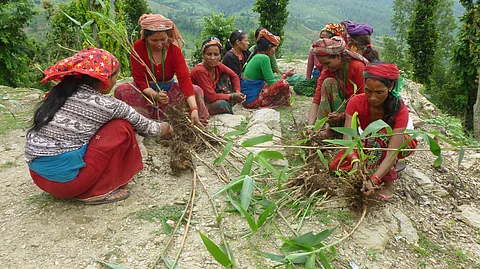

At a time when women are bearing the brunt of climate change across all sectors, more than 20,000 Community Forest User Groups (CFUG) in Nepal are raising funds from a wide array of sources to support climate change mitigation and adaptation initiatives.
Many of these women-led forest groups are restoring degraded lands through plantations, adopting agroforestry practices, preparing climate-smart operational plans, promoting forest foods, conserving water bodies, preventing forest fires, implementing soil conservation measures to combat erosion and introducing sustainable forest management strategies, among other efforts.
The main source of revenue for CFUGs is mainly the sale of goods and services derived from forest resources, payments for ecosystem services, membership fees and fines imposed for breaches of rules, said Sita Aryal, the executive director of Federation of Community Forestry Users Nepal (FECOFUN), a formal network of these groups. “CFUGs also receive financial support in the form of grants from various levels of government as well as from national and international non-profits,” she said.
However, in recent years, women-led grassroots organisations have remained severely underfunded when it comes to climate financing, according to a study by Rights and Resources, a global coalition of organisations. This is particularly the case for Indigenous peoples, local communities, Afro-descendant groups and women’s associations across the Global South engaged in climate action.
Across Nepal, CFUGs operate autonomously under their own operational plans. The evolution of community forestry in this small Himalayan country is a complex story of integration between social, political and environmental goals.
Community involvement in Nepal’s forestry sector began in the late 1970s, when the government acknowledged the ecological and administrative failures of a centralised forest management system, including increased deforestation, soil erosion and other environmental concerns in hilly areas. This prompted a series of reforms, starting with the Panchayat Forest Rules of 1978, which aimed to devolve forest management responsibilities to communities.
“This was officially the beginning of what has now grown to be one of the largest community forestry initiatives in the world,” Aryal said. The Forest Act of 1993 cemented this shift by granting user rights over government forests to local communities, provided they adhered to government-approved management plans.
The first CFUGs were formed in 1989 and recognised as autonomous, self-governing bodies. These groups were empowered to manage, use and distribute forest resources while retaining revenues from forest activities. By the late 1990s, Nepal’s community forestry model had garnered international recognition.
Since then, the programme has expanded significantly, with an increased focus on marginalised communities, particularly women, in leadership and decision-making roles. Today, 23,026 CFUGs are affiliated with FECOFUN, encompassing 3.19 million households and protecting more than 2.4 million hectares of forest.
Kumar Paudel, founder and director of Greenhood Nepal, a non-profit focused on wildlife, noted that although women’s leadership in forestry is growing, they still lag behind in decision-making roles. “There is a need for more women leaders in community forestry and conservation, as female leadership has proven both effective and efficient,” he said. “Women leading community forests is encouraging. It also serves as a valuable platform for leadership development that can prepare them for higher-level conservation roles in future.”
In India, women’s participation in forest management has yielded positive results in parts of Odisha’s Nayagarh district, where women regularly patrol forests to prevent fires and deter timber smugglers. In the late 1990s, when men failed to protect surrounding forest areas, women stepped in. Their participation is essential, as they depend heavily on forests for firewood and food.
To strengthen the rights of forest dwellers over forest resources, India enacted the Forest Rights Act (FRA) in 2006. The provision for Community Forest Resource Rights (CFRR) under the FRA mandates that forest governance and protection be carried out by local communities. However, reporting from several tribal villages in Chhattisgarh found that many women remained excluded from decision-making processes and many were unaware of the FRA. That said, a few single women noted they had benefitted from receiving individual land titles under the Act.
According to independent researcher Tushar Dash, the FRA provides a strong legal framework to recognise the rights of forest-dwelling communities over community forest resources.
Aryal noted that under community management, Nepal’s forests have shown signs of recovery, with improved biodiversity. “Community forestry has been linked to enhanced socio-economic outcomes for rural communities, especially women and marginalised groups, by ensuring access to vital forest products such as timber, firewood, fodder and medicinal plants,” she said.
But the road has not been without challenges. In India too, communities are pushing for more control under CFRR, despite the continued presence of Joint Forest Management Committees (JFMC), which some FRA experts argue should be disbanded.
While CFUGs in Nepal have gained global attention for their climate mitigation efforts, questions remain around equitable benefit-sharing among participants. Aryal acknowledged that the social diversity within CFUGs can complicate governance, as internal hierarchies and power dynamics sometimes lead to conflicts among different socio-economic groups.
In Nepal, the future of community forestry hinges on striking a balance between local needs and broader environmental and economic goals. In India, the success of CFRR under the FRA will similarly depend on greater community engagement, particularly of women, in regions affected by conflict. In such areas, the presence of military camps and armed guards around mining zones often restricts forest access. Some organisations, such as PRADAN, are working to boost women’s participation in implementing the FRA.